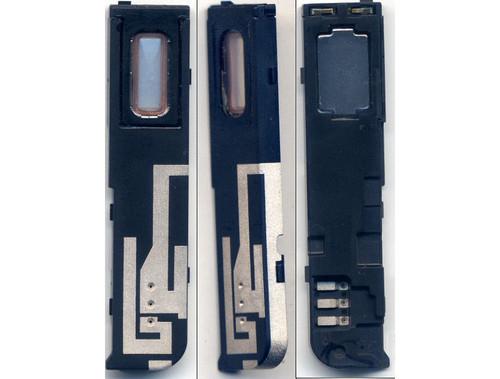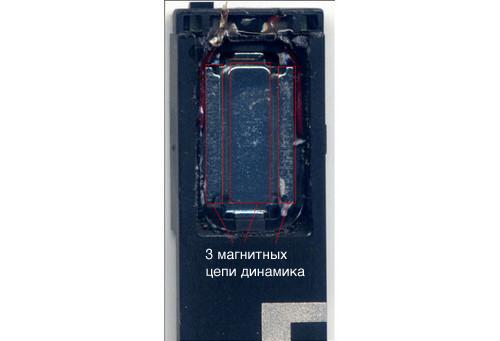OPPO Finder X907 - Thin Facts
Good day, Habr!
In the past topic parsing, we looked under the hood of the OPPO Finder, looked at it “as is”, without explanatory comments. Today’s article focuses on how OPPO engineers managed to make Finder so thin: let us present you some new facts about the “stuffing” of a smartphone.
Antenna and speaker system device
Everyone knows that the quality of receiving calls, data transmission and other functions of paramount importance directly depends on the structure of the smartphone's antenna. Creating an antenna for the Finder served as a challenge for OPPO engineers: unlike most super-thin models on the market, there are no bulges typical of this kind of smartphones on the back cover, the back panel is completely smooth, except for the protruding lens.
')
The basis of the antenna is the frame and audio box, which is used only by Apple and OPPO. Also, the antenna uses a technology for constructing three-dimensional radiation patterns, and the antenna itself is made using Laser Direct Structuring technology, which allows the antenna not to yield in performance and quality to its “thicker” competitors.
Antenna structure

Extremely little space was left for the GPS antenna, so only due to the careful arrangement of the elements for it the most suitable place was found at the top of the device. It also uses the technology of constructing three-dimensional radiation patterns and LDS. In most models, the antenna speaker is equipped with only one magnetic circuit, however, the OPPO Finder speaker consists of 3 magnetic circuits, which allows to improve the quality and increase the volume of signal transmission.

The audio box is made using the exclusive OPPO technology: the speaker, audio box and antenna are integrated into a single box, thereby reducing the space they occupy. Moreover, the vibrational space of the loudspeaker is increased, which allows for improved transmission of low frequencies.
Single box

Engineering explanation of the protruding lens
Initially, the camera lens protruded 1.7 mm from the body, later this protrusion was reduced to 1 mm, however, the protrusion was retained. What does this explain? This is the question we asked the OPPO engineers.
The thickness of the camera module is 4.9 mm, which is already a very small indicator. For comparison, most modules of 8-megapixel cameras are about 6 mm thick. Below is a diagram of the camera that will help us better understand the cause of the protrusion.
Camera components

With the exception of the protective film, all of the listed components are integral and, consequently, directly affect the thickness of the camera module. Moreover, standard 8-megapixel cameras typically use several lenses (usually 4), however, to improve the optical performance, 5 or more lenses must be used (5 is used in the OPPO Finder).

Usually, the farther the lens is, the easier it is to achieve a clear image. Thus, reducing the thickness of the lens only increases the number of tasks facing engineers. This problem was solved with the help of the Total Through Length technology, thanks to which a clear image was achieved with a relatively small distance between the lens and the image sensor. Sensor thickness is an example of 0.2 mm. As can be seen in the picture above, it is attached directly to the train. As you can see, the thickness of these elements is not significant compared to the other parts of the lens. The decisive role here is played by the area of the sensor itself. The image quality is associated with this parameter. In most of the flagships of 2011, a sensor with a diagonal of 1 / 3.2 inches (7.94 mm) was installed. It is obvious that with an increase in the support area of the structure, all its dimensions increase proportionally. Let us give examples for comparison: the thickness of an 8-megapixel iPhone 4S camera is 6 mm, the thickness of a similar Samsung Galaxy SII camera is 5.9 mm. It is for this reason that an innovative 1/4 inch (6.35 mm) BSI sensor was used in the OPPO Finder.

Only in this way it is possible to reduce the thickness of the camera, because with an increase in the area it is necessary to maintain a certain curvature of the lens, which is achieved only by increasing the structure. The diameter of the lens must be greater than or equal to the diagonal of the photosensitive sensor, otherwise there will be a “vignetting effect” at the corners of the image. Therefore, by reducing the diagonal of the sensor, you can also reduce the diameter of the lens.
However, this sounds simpler than it really is. Preserving the quality of shooting is much more complicated with a smaller lens. The lens thickness is 4 mm, and the sensor thickness is 0.2 mm. Total, 4.2 mm. Above it was indicated that the thickness of the OPPO Finder camera module is 4.9 mm, where is the remaining 0.7 mm? These 0.7 mm are made up of the rest of the details shown in the picture above, the thickness of the infrared filter is 0.3 mm, and the thickness of the cable is 0.4 mm. Having added all these indicators, we will get the total thickness of the camera module.
It is time to talk about the so-called "unaccounted" parts of the smartphone, which also add a lot of thickness to it. These are various kinds of shock-absorbing pads (total thickness 0.3 mm), dust-proof glass (0.3 mm), thickness of the touch screen and display (1.8 mm in total), board thickness (about 1 mm) and other factors.
Thus, we counted about 3.4 mm of “unaccounted thickness”. To prevent the camera from protruding from the case, we would have to place the camera module on top of all the above, and the phone would be 8.3 mm thick.
Thanks for attention! Have a nice day!
In the past topic parsing, we looked under the hood of the OPPO Finder, looked at it “as is”, without explanatory comments. Today’s article focuses on how OPPO engineers managed to make Finder so thin: let us present you some new facts about the “stuffing” of a smartphone.
Antenna and speaker system device
Everyone knows that the quality of receiving calls, data transmission and other functions of paramount importance directly depends on the structure of the smartphone's antenna. Creating an antenna for the Finder served as a challenge for OPPO engineers: unlike most super-thin models on the market, there are no bulges typical of this kind of smartphones on the back cover, the back panel is completely smooth, except for the protruding lens.
')
The basis of the antenna is the frame and audio box, which is used only by Apple and OPPO. Also, the antenna uses a technology for constructing three-dimensional radiation patterns, and the antenna itself is made using Laser Direct Structuring technology, which allows the antenna not to yield in performance and quality to its “thicker” competitors.
Antenna structure

Extremely little space was left for the GPS antenna, so only due to the careful arrangement of the elements for it the most suitable place was found at the top of the device. It also uses the technology of constructing three-dimensional radiation patterns and LDS. In most models, the antenna speaker is equipped with only one magnetic circuit, however, the OPPO Finder speaker consists of 3 magnetic circuits, which allows to improve the quality and increase the volume of signal transmission.

The audio box is made using the exclusive OPPO technology: the speaker, audio box and antenna are integrated into a single box, thereby reducing the space they occupy. Moreover, the vibrational space of the loudspeaker is increased, which allows for improved transmission of low frequencies.
Single box

Engineering explanation of the protruding lens
Initially, the camera lens protruded 1.7 mm from the body, later this protrusion was reduced to 1 mm, however, the protrusion was retained. What does this explain? This is the question we asked the OPPO engineers.
The thickness of the camera module is 4.9 mm, which is already a very small indicator. For comparison, most modules of 8-megapixel cameras are about 6 mm thick. Below is a diagram of the camera that will help us better understand the cause of the protrusion.
Camera components

With the exception of the protective film, all of the listed components are integral and, consequently, directly affect the thickness of the camera module. Moreover, standard 8-megapixel cameras typically use several lenses (usually 4), however, to improve the optical performance, 5 or more lenses must be used (5 is used in the OPPO Finder).

Usually, the farther the lens is, the easier it is to achieve a clear image. Thus, reducing the thickness of the lens only increases the number of tasks facing engineers. This problem was solved with the help of the Total Through Length technology, thanks to which a clear image was achieved with a relatively small distance between the lens and the image sensor. Sensor thickness is an example of 0.2 mm. As can be seen in the picture above, it is attached directly to the train. As you can see, the thickness of these elements is not significant compared to the other parts of the lens. The decisive role here is played by the area of the sensor itself. The image quality is associated with this parameter. In most of the flagships of 2011, a sensor with a diagonal of 1 / 3.2 inches (7.94 mm) was installed. It is obvious that with an increase in the support area of the structure, all its dimensions increase proportionally. Let us give examples for comparison: the thickness of an 8-megapixel iPhone 4S camera is 6 mm, the thickness of a similar Samsung Galaxy SII camera is 5.9 mm. It is for this reason that an innovative 1/4 inch (6.35 mm) BSI sensor was used in the OPPO Finder.

Only in this way it is possible to reduce the thickness of the camera, because with an increase in the area it is necessary to maintain a certain curvature of the lens, which is achieved only by increasing the structure. The diameter of the lens must be greater than or equal to the diagonal of the photosensitive sensor, otherwise there will be a “vignetting effect” at the corners of the image. Therefore, by reducing the diagonal of the sensor, you can also reduce the diameter of the lens.
However, this sounds simpler than it really is. Preserving the quality of shooting is much more complicated with a smaller lens. The lens thickness is 4 mm, and the sensor thickness is 0.2 mm. Total, 4.2 mm. Above it was indicated that the thickness of the OPPO Finder camera module is 4.9 mm, where is the remaining 0.7 mm? These 0.7 mm are made up of the rest of the details shown in the picture above, the thickness of the infrared filter is 0.3 mm, and the thickness of the cable is 0.4 mm. Having added all these indicators, we will get the total thickness of the camera module.
It is time to talk about the so-called "unaccounted" parts of the smartphone, which also add a lot of thickness to it. These are various kinds of shock-absorbing pads (total thickness 0.3 mm), dust-proof glass (0.3 mm), thickness of the touch screen and display (1.8 mm in total), board thickness (about 1 mm) and other factors.
Thus, we counted about 3.4 mm of “unaccounted thickness”. To prevent the camera from protruding from the case, we would have to place the camera module on top of all the above, and the phone would be 8.3 mm thick.
Thanks for attention! Have a nice day!
Source: https://habr.com/ru/post/170905/
All Articles